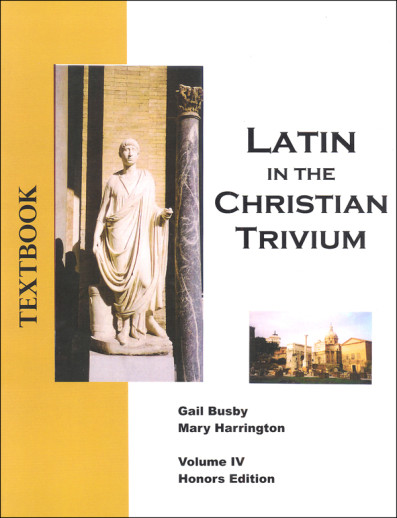We use cookies to make your experience better. To comply with the new e-Privacy directive, we need to ask for your consent to set the cookies. Learn more.
Latin in the Christian Trivium Volume IV Textbook (Honors)
This thorough study of Latin makes the language interactive for students, with an engaging storyline and notebooking activities. There are no myths or gods/goddess in this protestant series. It has received positive reviews from Cathy Duffy and Old Schoolhouse. James Stobaugh also highly recommends this program. This program is accredited by the University of California as well.
Using a notebook approach, kids organize the material from the beginning. They make note cards to keep different concepts clear with color coding. As with most languages, the first two levels are a lot of grammar and vocabulary while the latter years are more writing and topic centered. Bible verses are used for translation exercises and there is a lot of interesting historical information at every level. In fact, the Bible in Latin is the primary reading source. Pronunciation follows "church" Latin (also known as ecclesiastical pronunciation).
The program describes the stages of learning in computer terms. Stage 1 is the grammar stage and it is where data is being input. Stage 2 is the dialectic or logic stage and that is when data is being processed. Then in stage 3, the rhetoric stage, represents data output.
From the beginning, the teacher is guided in every way. The teacher's guide has everything the student sees in the text plus the answers. You are told exactly how to set up your notebook and what colors to use for the note cards. For example, if you are using a binder with tabs, you are told how to divide and label the sections into topics, such as "phrases." For the cards, it tells you to write verbs on white cards with black ink and feminine nouns on pink cards with black ink. Doing this from the beginning lays the ground work for years of well-organized learning habits.
Volume 1 begins with a grammar review and talks about the Roman alphabet. Students are introduced to a Roman family. Lessons make sense and include some history. There are translation exercises as grammar points are brought to light. The Our Father prayer is in the back. Areas of the language covered include: 1st conjugation verbs, 1st declension nouns, conjunctions, direct objects, some adjectives, prepositions, 2nd declension nouns, numerals, imperfect and future tenses, imperative mood, ablative, accusative, 3rd declension nouns, 2nd conjugation verbs and irregular adjectives.
Subject areas include: Gaule, a brief history of Italy, Roman roads, Rome itself, the calendar, Circus Maximus, Roman character and art, monarchy, republic, Judea, the Vulgate by Jerome, and history of the Bible. There is plenty of English used in this volume to explain concepts.
Volume 2 again begins with a review of grammar. Students go more in depth in both grammar and vocabulary in this volume as you would expect. Students are given the projects of creating an etymology poster and an oral report. There are very specific guidelines and instruction for the parent and student. Language areas covered include: 3rd declension adjectives, partitive genitive, perfect tense, future perfect, more 3rd conjugation verbs, predicate accusative, passive voice, demonstratives, 4th declension, accusative of space, and more participles.
Subject areas covered include: Daniel in the lion's den, King Herod, Luke 1, Jonah and the whale, journey to Cana, birth of Jesus, Capernaum, Psalm One, speech on the mountain, shepherd's story, the Roman arch, food in Biblical times, Bethlehem, and education in Israel. There is a large glossary in the back.
Volume 3 asks students to write a term paper on Julius Caesar. You are given a deadline of 6 weeks and specific guidelines along the way. There is new grammar and more application and refining of what has been learned thus far.
Language areas to be covered include: special translation of causa, 5th declension, reflexives, subjunctive mood, indirect questions, clauses of purpose, impersonal verbs, dative with intransitive verbs, and a review preparing students for the Latin exam. There is a large Latin/English glossary in the back.
Subject areas to be covered include: Nain, dinners, Roman homes, Galilee, Capernaum, Thanksgiving, Jerusalem, Mary and Martha, Zaccheus, the good Samaritan, the 1st Sabbath, Cicero,
In Volume 4, the student's project is to write a travel diary for an imaginary trip from Jerusalem to Britain. You may choose any time period in history and must organize it in a daily format. There are more specific do's and don'ts in the instructions. There is no new grammar instruction here, so all learning is done through applying what has been learned thus far. Content includes a variety of subjects such as: Caesar, Jerusalem, Hercules, Acts of the Apostles, Pentecost, persecution, Esther, love, the 10 Commandments, Venerable Bede, James V, Cicero, Deacon Stephen, Seneca, Psalms, Job, the Aenid, Melitia, and what it means to be good.
Each volume has several components that work together for a complete study.
This program holds up well in comparison to other Latin series in its academic content and the ease of presentation. It assumes that the parent does not have prior Latin experience. Latin is a tough subject in any form, but the separate elements make it feel less daunting for both parents and students. ~ Sara
| Product Format: | Softcover Book |
|---|---|
| Grades: | 9-AD |
| Brand: | XL Group |
| Author: | Gail Busby & Mary Harrington |
| Length in Inches: | 11 |
| Width in Inches: | 8.5 |
| Height in Inches: | 1 |
| Weight in Pounds: | 1.85 |

